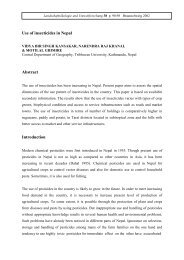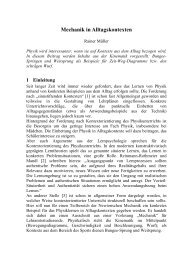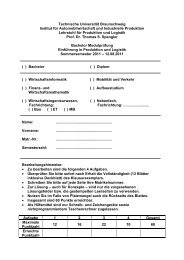Investigation of the electrocatalytic oxidation of formate and ethanol ...
Investigation of the electrocatalytic oxidation of formate and ethanol ...
Investigation of the electrocatalytic oxidation of formate and ethanol ...
Create successful ePaper yourself
Turn your PDF publications into a flip-book with our unique Google optimized e-Paper software.
J Solid State Electrochem (2006) 10:872–878 875<br />
Current / mA<br />
35<br />
30<br />
25<br />
20<br />
15<br />
10<br />
5<br />
0<br />
0 5 10 15 20 25 30 35 40 45 50 55<br />
Time / min<br />
Fig. 3 Chronoamperometric experiment <strong>of</strong> <strong>the</strong> <strong>electrocatalytic</strong> <strong>oxidation</strong><br />
<strong>of</strong> <strong>formate</strong> (100 mM) in 100 mM phosphate buffer solution, pH 7.<br />
(A) Polyaniline modified platinum black electrode (Pt-PANI) in<br />
<strong>formate</strong> solution; (B) Pt-PANI in hydrogen saturated <strong>formate</strong> solution;<br />
(C) platinum black electrode in <strong>formate</strong> solution; (D) Pt black<br />
electrode in hydrogen saturated <strong>formate</strong> solution. The potential <strong>of</strong><br />
<strong>the</strong> electrodes was 0.2 V. The arrows indicate <strong>the</strong> application <strong>of</strong> <strong>the</strong><br />
regenerative oxidative potential pulsing procedure (1 V, 5 s; <strong>the</strong><br />
current recording was paused during <strong>the</strong> pulsing)<br />
The decrease <strong>of</strong> <strong>the</strong> <strong>formate</strong> concentration by 85% during<br />
<strong>the</strong> experiment shows that <strong>formate</strong> was efficiently electrooxidized.<br />
As shown in Table 1, <strong>the</strong> electrochemical<br />
conversion <strong>of</strong> <strong>formate</strong> is almost identical with <strong>the</strong> conversion<br />
found by chemical analysis (deviation <strong>of</strong> 3.7% only).<br />
Cyclic voltammograms, recorded after <strong>the</strong> potentiostatic<br />
experiment, confirm that <strong>the</strong> current decrease is mainly<br />
caused by substrate exhaustion (Fig. 1a-B <strong>and</strong> a-C). Readdition<br />
<strong>of</strong> substrate—in this case, to a final concentration<br />
<strong>of</strong> 75 mM <strong>formate</strong>—doubled <strong>the</strong> current density (I-C).<br />
Never<strong>the</strong>less, <strong>the</strong> lower current density, compared to <strong>the</strong><br />
initial values, indicates that irreversible poisoning effects<br />
also play some role. The most probable explanation for <strong>the</strong><br />
beneficial role <strong>of</strong> <strong>the</strong> oxidative pulsing is <strong>the</strong> oxidative<br />
stripping <strong>of</strong> blocking compounds from <strong>the</strong> electrode<br />
surface. However, it cannot be excluded that <strong>the</strong> cyclic<br />
polarisation also leads to surface reconstructions resulting<br />
in keeping <strong>the</strong> real electrode surface area <strong>of</strong> <strong>the</strong> active<br />
platinum large. This will be <strong>the</strong> subject <strong>of</strong> fur<strong>the</strong>r studies.<br />
As expected, <strong>the</strong> electro-<strong>oxidation</strong> <strong>of</strong> <strong>ethanol</strong> was<br />
considerably less efficient than <strong>the</strong> <strong>formate</strong> <strong>oxidation</strong>. At<br />
low potentials, <strong>the</strong> <strong>oxidation</strong> usually ends at <strong>the</strong> state <strong>of</strong><br />
acetaldehyde, <strong>the</strong> fur<strong>the</strong>r <strong>oxidation</strong> to acetate usually<br />
requires higher <strong>oxidation</strong> potentials or <strong>the</strong> supporting effect<br />
<strong>of</strong> alloy metals, such as ru<strong>the</strong>nium or tin [7]. At <strong>the</strong><br />
beginning <strong>of</strong> <strong>the</strong> experiments, average current densities <strong>of</strong><br />
about 700 μA cm −2 were achieved. As in <strong>the</strong> case <strong>of</strong><br />
<strong>formate</strong> <strong>oxidation</strong>, an electrode deactivation was observed,<br />
which could partly be overcome by using <strong>the</strong> described<br />
D<br />
C<br />
B<br />
A<br />
oxidative potential pulsing procedure (Fig. 2b). However,<br />
after 17 h <strong>of</strong> potentiostatic electrolyses, <strong>the</strong> current density<br />
decreased to 250 μA cm −2 , although about 91% <strong>of</strong> <strong>the</strong><br />
substrate was still present in <strong>the</strong> electrolyte solution<br />
(Table 1). As shown in <strong>the</strong> cyclic voltammograms in<br />
Fig. 1(b-B), <strong>the</strong> current decrease goes along with a decrease<br />
<strong>of</strong> <strong>the</strong> <strong>electrocatalytic</strong> activity <strong>of</strong> <strong>the</strong> Pt black electrode.<br />
In Table 1, <strong>the</strong> data <strong>of</strong> <strong>the</strong> coulometric <strong>and</strong> molar<br />
analysis <strong>of</strong> <strong>the</strong> experiments are provided. They show that<br />
<strong>the</strong> products <strong>of</strong> <strong>the</strong> <strong>ethanol</strong> <strong>oxidation</strong>, determined by HPLC,<br />
are mainly acetaldehyde (6 mM) <strong>and</strong> acetate (1.2 mM). A<br />
comparison <strong>of</strong> <strong>the</strong> <strong>the</strong>oretical <strong>and</strong> <strong>the</strong> experimental recovery<br />
rate (162 C <strong>and</strong> 121 C, respectively) reveals a deviation <strong>of</strong><br />
about 25%. This deviation is to be ascribed to <strong>the</strong><br />
contribution <strong>of</strong> <strong>the</strong> oxidative electrode regeneration procedure<br />
to <strong>the</strong> substrate <strong>oxidation</strong>: Only during <strong>the</strong> regeneration<br />
steps (1 V, 5 s, every 1,000 s) adsorbed <strong>ethanol</strong> is<br />
oxidized to acetate, at 0.2 V <strong>the</strong> <strong>oxidation</strong> terminates at <strong>the</strong><br />
stage <strong>of</strong> acetaldehyde. Calculating <strong>the</strong> expected charge from<br />
<strong>the</strong> amount <strong>of</strong> acetaldehyde formed during <strong>the</strong> electrolyses<br />
supports this assumption, as <strong>the</strong> calculated 116 C are in<br />
good agreement with <strong>the</strong> experimental results.<br />
An interesting finding <strong>of</strong> this study was that <strong>the</strong> extent <strong>of</strong><br />
<strong>ethanol</strong> <strong>oxidation</strong> could not be enhanced by increasing <strong>the</strong><br />
mass transport via stirring. This result is indicative <strong>of</strong> <strong>the</strong><br />
particularly slow <strong>oxidation</strong> <strong>of</strong> <strong>the</strong> adsorbed <strong>ethanol</strong> at bare<br />
platinum under our experimental conditions.<br />
As we have shown before, <strong>the</strong> poisoning <strong>of</strong> platinum<br />
electrocatalysts, used as anode material for direct hydrogen<br />
<strong>oxidation</strong> in microbial fuel cells, is significantly decreased<br />
when <strong>the</strong> electrode is covered by a layer <strong>of</strong> a conductive<br />
polymer (polyaniline or its derivates [20]). Most likely, this<br />
protection can be attributed to an increased tolerance <strong>of</strong> <strong>the</strong><br />
electrocatalyst against poisoning as <strong>the</strong> result <strong>of</strong> <strong>the</strong><br />
interaction <strong>of</strong> <strong>the</strong> electronic structure <strong>of</strong> <strong>the</strong> polymer with<br />
<strong>the</strong> precious metal surface [23–25]. To compare polyaniline<br />
modified platinum (Pt-PANI) with unmodified platinum,<br />
both electrodes were tested towards <strong>the</strong>ir <strong>electrocatalytic</strong><br />
activity for <strong>formate</strong> <strong>oxidation</strong> in <strong>the</strong> absence as well as in<br />
<strong>the</strong> presence <strong>of</strong> hydrogen in <strong>the</strong> solution. The results are<br />
presented in Fig. 3. A number <strong>of</strong> quite remarkable details<br />
can be derived from this figure. The first observation is <strong>the</strong><br />
fact that <strong>formate</strong> <strong>oxidation</strong> at Pt-PANI is not possible.<br />
In Fig. 3, curve (A), it appears that <strong>the</strong> polymer layer<br />
physically blocks <strong>the</strong> organic substrate from approaching<br />
<strong>the</strong> electrocatalyst. The unmodified platinum black electrode<br />
shows <strong>the</strong> typical saw-tooth like shape <strong>of</strong> <strong>the</strong> current–<br />
time curve, caused by <strong>the</strong> regular reactivation <strong>of</strong> <strong>the</strong><br />
electrode. When hydrogen is bubbled through <strong>the</strong> <strong>formate</strong><br />
solution, <strong>the</strong> additional depolarizer leads to an almost equal<br />
increase <strong>of</strong> <strong>the</strong> current at both Pt <strong>and</strong> Pt-PANI electrodes<br />
(curves B <strong>and</strong> D), showing that both electrodes possess a<br />
similar <strong>electrocatalytic</strong> activity towards hydrogen <strong>oxidation</strong>.











